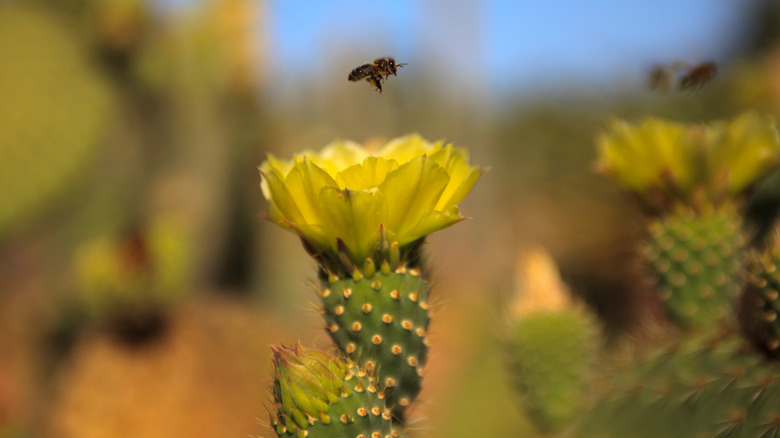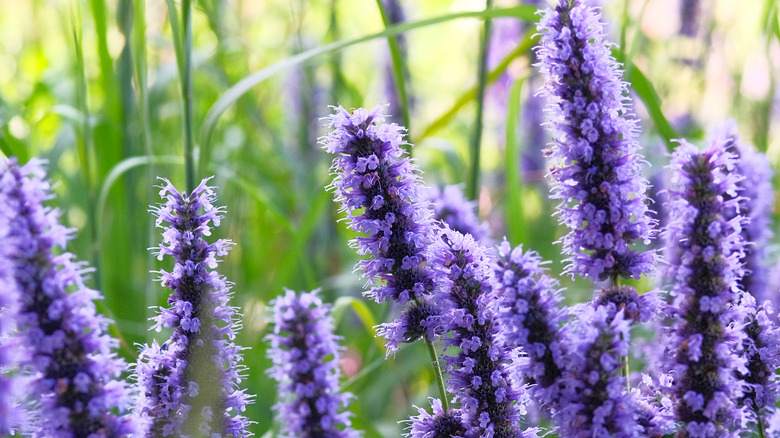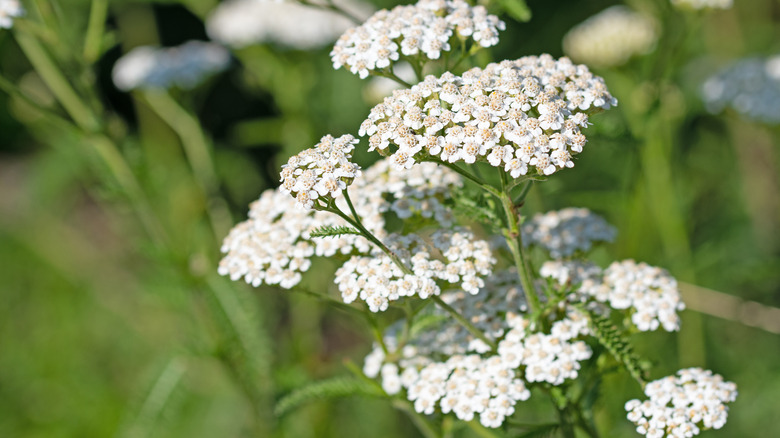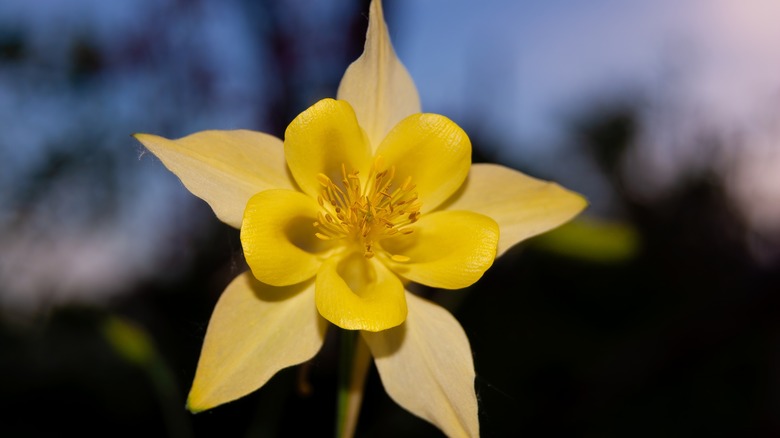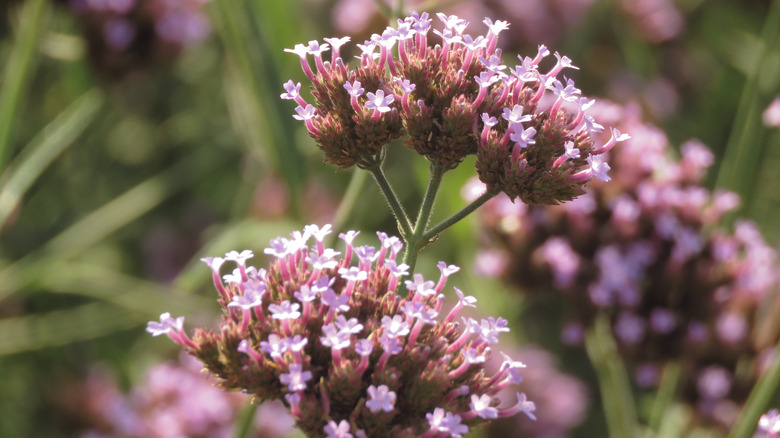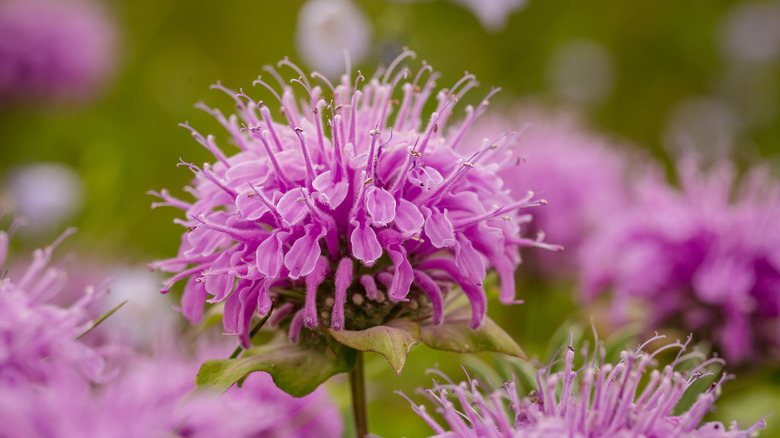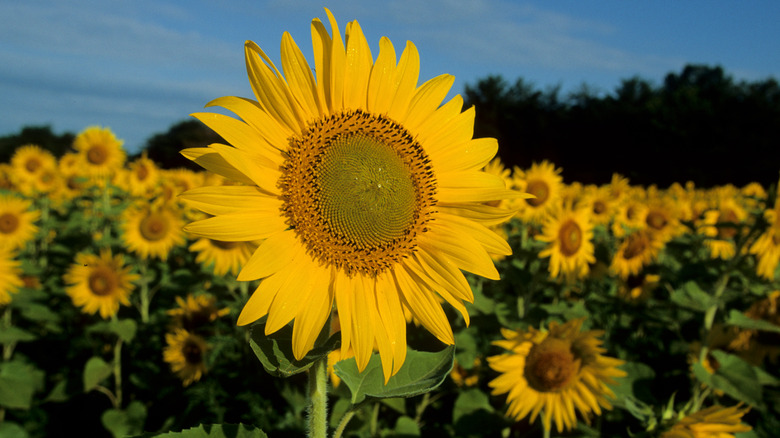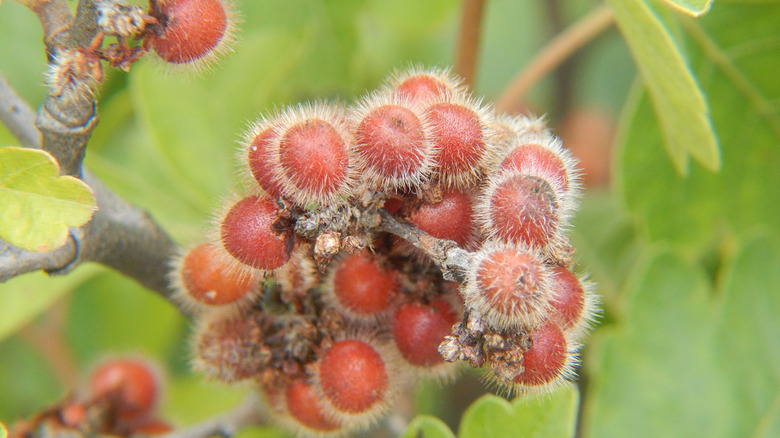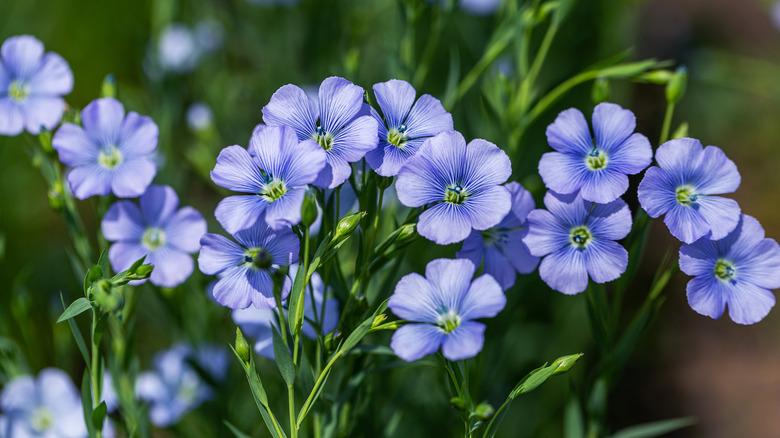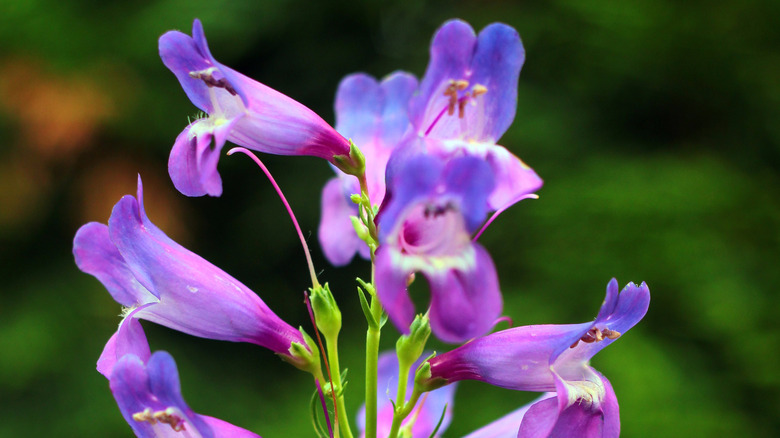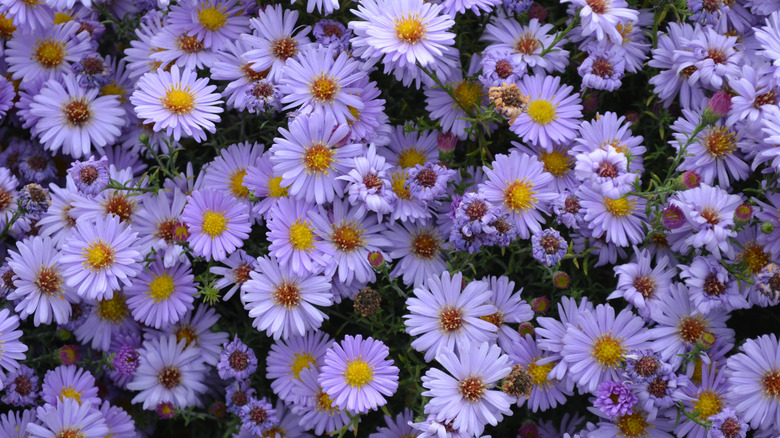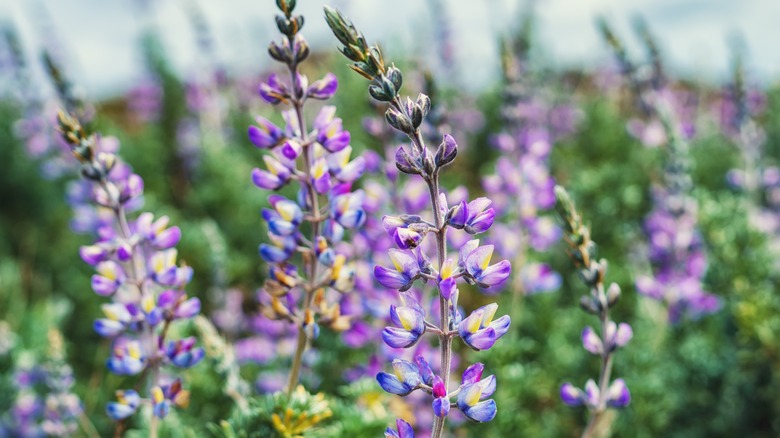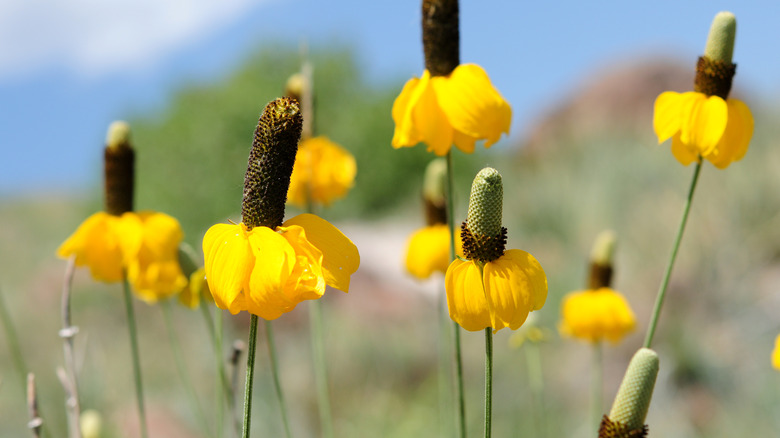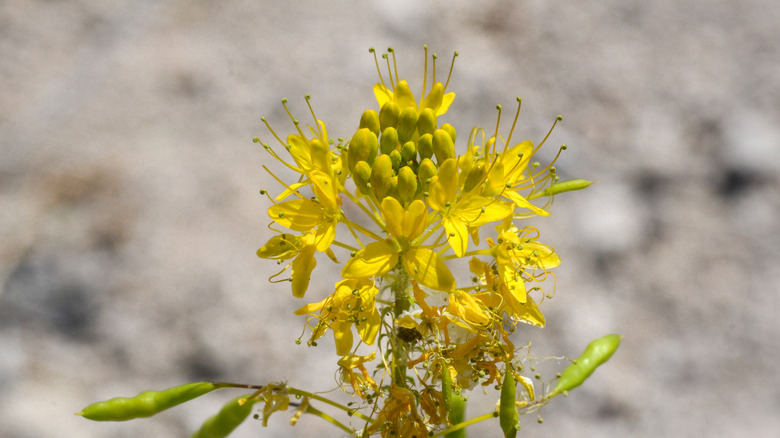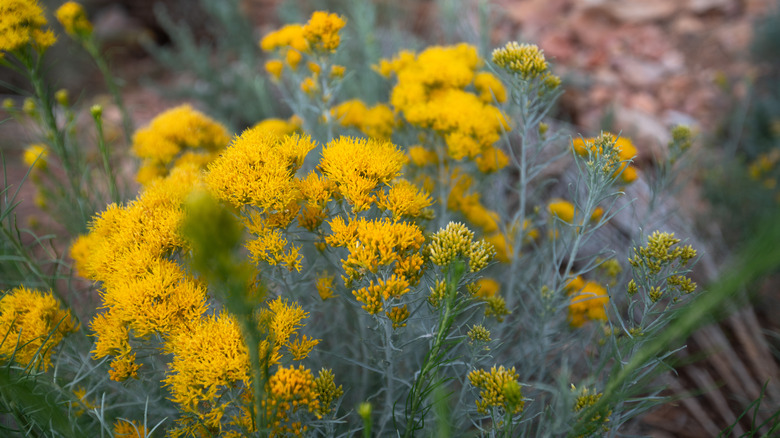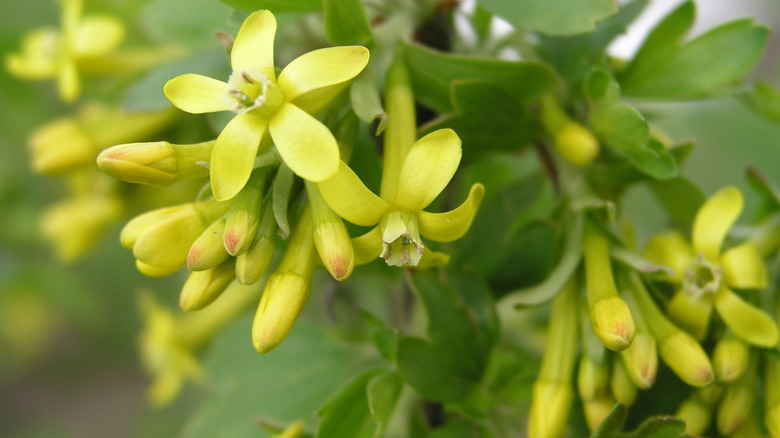15 Bee-Friendly Flowers To Grow If You Live In The Southwest
The Southwestern region of the United States is comprised primarily of Arizona, Nevada, New Mexico, and Utah, though California and Colorado are occasionally considered a member as well. Known for arid mountain deserts, desperate droughts, and rugged terrain, the soils of the Southwest can seem hardly friendly to pollinators. Especially when it comes to your maintaining your own home garden. But actually, the key is finding native plants that are built to thrive in these harsh conditions, and that the native bee populations have spent generations getting to know.
With about 4,000 species of native bees in the United States, roughly 1,000 of them can be found in the Sonora Desert region of Arizona alone, according to the Arizona-Sonora Desert Museum. The other Southwest states boast similar numbers. Because of this, it's essential that gardeners in these regions fill their gardens with bee-friendly plants to preserve these precious populations.
We'll walk through some of the best flowers for pollinating bees that you can plant in your Southwest garden. Keep in mind the specific species of some flowers will be specific to your state, and you should research to find out which is best or speak to your local native nursery.
1. Hyssops
Hyssops (Hyssopus officinalis) is a flowering shrub and member of the mint family. Similar in appearance to lavender, hyssops grow in columnar clusters with tiny blossoms that are great for native bees. According to Western Forbs, the Nettleleaf Giant Hyssop is native and common throughout the Southwest, making it a great addition to your desert garden.
Nettleleaf Giant Hyssops need wet to dry, neutral to alkaline soil, full to partial sun, and grow in USDA hardiness zones 3-9. These plants can grow extremely tall (up to 6 feet!) so they can be a great privacy barrier as well.
2. White yarrow
According to the U.S. Forest Service, common yarrow (Achillea millefolium) has been used for hundreds of years by indigenous people of America for its healing properties. But because of its sweet fragrance and umbrella-like blossoms that make for a perfect landing strip, bees are also huge fans of yarrow flowers.
These hardy plants thrive in USDA zones 3-9, even in nutrient-poor soil. Plant yarrow in neutral, well-drained soil and full sun exposure; it can reach up to 3 feet tall and 3 feet wide at full maturity.
3. Columbines
Part of the Ranunculaceae family, the columbine (genus Aquilegia) is a stunning flower known for its double-flower petals. The best type of columbine for the Southwest varies from state to state, but the desert columbine (Aquilegia desertorum) can grow in Arizona, New Mexico, and Utah, says the U.S. Forest Service, while, according to The American Southwest, the Sierra columbine (Aquilegia Pubescens) is found in Nevada and the Sierra Nevada mountains of California.
Columbines can do well in moist, neutral to slightly acidic soil, even in high-elevation deserts and mountains, USDA zones 3-8, and requires full sun exposure. Height varies by species.
4. Milkweeds
Milkweeds (genus Asclepias) aren't weeds at all, but rather an herbaceous perennial that have a signature milky sap that's irresistible to bees and other pollinators, and per the National Wildlife Federation, is the sole food source of monarch butterflies.
A good choice for your Southwestern native garden is showy milkweed (Asclepias speciosa), but you can have your pick of the lot, as the American Southwest is home to 41 of 76 native milkweed plants found in the continental United States, per the USDA. Milkweed grows in USDA zones 4-9, well-drained soil of nearly any kind, and needs full sun.
5. Rocky Mountain bee plant
The Rocky Mountain bee plant (Cleome serrulata) is a stunning, spindly flower, sometimes known as a spider plant. The U.S. Forest Service notes these flowers can be found in the least likely of places, like waste management facilities. These cleomes are also known as stinking clovers due to their unpleasant odor that keeps most animals at bay. That is, except bees, as you may guess by the name.
Growing from 1.5 to 5 feet tall, the spider flower thrives in acidic-neutral average garden soil or loam with partial sun exposure and USDA zones 10 and 11.
6. Common sunflower
One of the happiest flowers, sunflowers (Helianthus annus) are also one of the very best to plant for bees in the Southwest region. Just be sure to pick a variety that actually provides food, as engineered flowers may actually repel bees instead of attract them.
Sunflowers are vitally important to bees and other pollinators as they can provide both pollen and nectar, says Carolina Honeybees. Sunflowers do well in well-draining soil with full exposure to sunlight, thrive in the USDA zones 2-11, and can grow between 3 and 10 feet tall.
7. Skunkbush sumac
Have you ever realized you can find sumac outside of your pantry and right in your own backyard? Skunkbush sumac (Rhus trilobata) grows in much of North America, including the Southwest. While we love sumac for its tangy, citrus-like spice in cooking, bees love the flowers that precede the fruits, which are cream-yellow blossoms, per Great Plains Nursery.
In the Southwest, these berries tend to grow in shorter clusters, but thrive in USDA zones 4-6, full sun, and nearly any slightly acidic to slightly neutral soil.
8. Prairie flax
Prairie flax flowers (Linum lewisii) are an incredible flower for bees, even receiving recognition for providing Special Value to Native Bees by pollination ecologists, according to the Lady Bird Johnson Wildflower Center. They can withstand extreme droughts, making them an ideal addition to water conservationist Southwest gardens.
These summer bloomers require full sun exposure, but can grow in nearly any loamy soil — acidic, neutral, or alkaline, and USDA zones 2-11. They can grow quite tall, up to about 3 feet tall, and around 1 foot wide.
9. Penstemons
Also known as beardtongue, these trumpeting flowers can be found in even the harshest of terrains, including Utah's craggy, desolate rocky mountains, which are home to over 100 species of penstemons, reports Wild About Utah. While these blooms look perfectly delicate, they can withstand drought, heat, and cold shockingly well, making them one of the hardiest species.
To attract bees, be sure to plant purple, blue, and white varieties, as their red counterparts are better suited to hummingbirds. Penstemons are suited to USDA zones 3-8, neutral to acidic well-drained soil, and full sun exposure.
10. Asters
Closely related to the daisy, asters are members of the Asteraceae family. They typically have sunshiney yellow eyes and pale purple and pink petals. They also bloom in the fall, making them an incredibly valuable late-season nectar and pollen source for bees, notes The Bee Gardener. Their shallow central discs also make them ideal for small and short-tongued bees.
Plant asters in USDA zones 3-8 in well-drained neutral to acidic soil with full sun exposure. Asters can grow up to 4 feet wide and 6 feet tall, making them an excellent filler flower for your garden.
11. Lupines
Lupines (genus Lupinus) are sometimes known as bluebonnets, but they actually blossom in many shades of purple and pink as well. Part of the legume family, lupines are a sturdy stock with over around 200 unique species, per GrowingVale. In fact, Nevada, Arizona, and New Mexico have native species of their own — Nevada Lupines (Lupinus nevadensis), Arizona Lupines (Lupinus arizonicus), and New Mexico Lupines (Lupinius neomexicanus), respectively.
Some general growing notes for lupines are to use rich, moist, and well-drained soil for planting and to ensure they have full sun exposure. You can find lupines growing in USDA zones 4-8, per Plant Addicts.
12. Upright prairie coneflower
Sometimes known as the Mexican hat flower given its resemblance to the traditional sombrero, these gorgeous flowers are now referred to as upright prairie coneflowers (Ratibida columnifera), as the former can be seen as appropriative.
Coneflowers are a favorite of bees, and their strong scent actually puts deer off, notes Prairie Pollination, which makes this a great plant for mountain gardens. Prairie cone flowers prefer loamy, neutral to alkaline, well-drained soil, and can survive with very little water, and at least six hours of sun exposure each day. They can survive in USDA zones 4-9.
13. Yellow bee plant
Also known as a variety of spider flower, and very closely related to the Rocky Mountain bee plant (Cleome serrulata), the yellow bee plant (Cleome lutea) is an extremely hardy plant that can thrive in mountains, foothills, and semi-deserts, growing at a limit of 7,200 feet in elevation, says Range Plants of Utah.
Not at all a fussy plant, yellow bee flowers can grow in any pH level but prefer sandy and loamy soils, full sun exposure, and fall in USDA zones 3-8.
14. Rubber rabbitbrush
When you're in a sagebrush desert, keep an eye out for its closely related family member rubber rabbitbrush (Ericameria nauseosa). Its name isn't a figure of speech, the sap of this brush contains actual rubber, which was tested as a rubber source during World War II, according to the U.S. Forest Service. Indigenous people of America used this plant as tea, dye, and even chewing gum!
A perfect addition to a xeriscaped garden, rubber rabbitbrush can grow in slightly acidic, neutral, and highly alkaline sandy, coarse soil, full sun exposure, and USDA zones 4-9.
15. Golden currant
A gorgeous flowering perennial shrub, the golden currant (Ribes aureum) is an incredible early-season food source for bees, and requires far less water than many other currant species, notes The Bee Gardener. They bloom around mid-February, a time when flowering plants are rare and desperately sought out by bees.
You can use both the berry fruit and flowers for culinary uses — the flowers have a spicy, vanilla scent that is great in ice cream or pie. Plant the golden currant shrub in moist, well-draining soil with partial sunlight; it tolerates some shade and grows in USDA zones 5-8.
